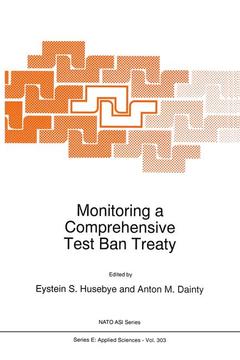Monitoring a Comprehensive Test Ban Treaty, 1996 NATO Science Series E: Series, Vol. 303
Langue : Anglais
Coordonnateurs : Husebye Eystein S., Dainty Anton M.

An international treaty banning the testing of any nuclear device in any environment - a comprehensive test ban treaty (CTBT) - has been on the political agenda for nearly 40 years. Objections to a CTBT have been political, technical, or a combination of both. However, the possibilities seem better after the end of the Cold War. In the prevailing, cooperative disarmament climate a CTBT appears likely to be approved by most countries in 1996. Hence the great current interest in monitoring technologies and capabilities.
Such issues are comprehensively addressed here, a preamble being devoted to the political developments and setbacks over the past 40 years. Since seismic means are considered the dominant monitoring element, they are explored in detail. Contributions cover network deployments, advanced signal processing, wave propagation in heterogeneous media, and seismic source representations, and a variety of techniques for source classification (including neuralnetworks). Complementary monitoring techniques, such as hydroacoustics, radionuclides and infrasound, are also summarised. The IAEA operation for monitoring compliance with the Non-Proliferation Treaty is also presented.
The book also includes eyewitness accounts of the Soviet 50 Mt megabomb development and test, as well as the efforts made by the state to monitor the nuclear test programmes of the western powers. Includes some 33 articles written by distinguished scientists active in CTBT monitoring research for decades.
Such issues are comprehensively addressed here, a preamble being devoted to the political developments and setbacks over the past 40 years. Since seismic means are considered the dominant monitoring element, they are explored in detail. Contributions cover network deployments, advanced signal processing, wave propagation in heterogeneous media, and seismic source representations, and a variety of techniques for source classification (including neuralnetworks). Complementary monitoring techniques, such as hydroacoustics, radionuclides and infrasound, are also summarised. The IAEA operation for monitoring compliance with the Non-Proliferation Treaty is also presented.
The book also includes eyewitness accounts of the Soviet 50 Mt megabomb development and test, as well as the efforts made by the state to monitor the nuclear test programmes of the western powers. Includes some 33 articles written by distinguished scientists active in CTBT monitoring research for decades.
I. Principal Political and Technical Test Ban Issues.- Importance of a CTB for the Durability of the NPT.- Three Interesting Episodes in the Soviet Nuclear Program.- Attempts to Ban Nuclear Tests- A Disappointing Story.- Monitoring of Underground Nuclear Tests by Seismic Stations in the Former Soviet Union (FSU).- Seismological Methods for Monitoring a CTBT: The Technical Issues Arising in Early Negotiations.- Russian Experience in Global Seismic Monitoring.- II. Monitoring Technologies.- Monitoring Compliance under Article III of the Treaty on the Non-Proliferation of Nuclear Weapons.- The Department of Energy’s Comprehensive Test Ban Treaty Research and Development Program.- The Russian Federation Proposal on the CTBT Global Monitoring System.- Signatures of Testing: On-Site Inspection Technologies.- Atmospheric Methods for Nuclear Test Monitoring.- Airborne Radionuclides of Concern and Their Measurement in Monitoring a Comprehensive Test Ban Treaty.- Atmospheric Radionuclide Monitoring: A Swedish Perspective.- Hydroacoustic Surveillance of the Oceans and its Relevance to Monitoring of Seismic Events.- Geophysical and Geological Databases and CTBT Monitoring: A Case Study of the Middle East.- III. Explosion and Earthquake Source Modeling.- Types of Seismic Events and Their Source Descriptions.- Dealing with Decoupled Nuclear Explosions under a Comprehensive Test Ban Treaty.- Methods of Evading Detection by a Nuclear Explosion Monitoring Network under Special Conditions.- Seismic Source Size and Yield for Nuclear Explosions.- Seismic Results from DOE’s Non-Proliferation Experiment: A Comparison of Chemical and Nuclear Explosions.- Regional Source Parameters, Seismic Energy, and Discrimination.- Seismicity Induced by Mining: An Overview.- IV. Seismic Networks.- Towards a Global Seismic Monitoring System — Lessons Learned from Geneva Experiments.- Generalized Beamforming, Phase Association and Threshold Monitoring using a Global Seismic Network.- Broadband and ArrayObservations at Low Noise Sites in Kazakhstan: Opportunities for Seismic Monitoring of a Comprehensive Test Ban Treaty.- Monitoring Earthquake Activity Offshore Iberia.- Event Location and Source Characterisation.- Structure at the Top and Bottom of the Mantle- Two Examples of Use of Broad-Band Data in Seismic Tomography.- Expanding the Global Seismographic Network.- V. Signal Processing and Seismic Wave Propagation.- Algorithms for Adaptive Statistical Processing of Seismic Array Data.- Retrieving Signals from Array Data.- Trinity or Verity?.- Array Processing by Phase Regression.- Attenuation and Blockage of Lg in Eurasia.- Lg Wave Attenuation and Propagation Characteristics in Iran.- The Influence of Seismic Scattering on Monitoring.- VI. Seismic Source Discrimination Technologies.- Regional Seismic Event Discrimination.- Resolving Regional Discrimination Problems: Some Case Histories.- Extracting and Processing Signal Parameters for Regional Seismic Event Identification.- A Reviewof Broadband Regional Discrimination Studies of NTS Explosions and Western U.S. Earthquakes.- Neural Networks in Seismic Discrimination.- Statistical Approaches to Seismic Discrimination.- Seismic Source Discrimination at Teleseismic Distances—Can We Do Better?.
'I recommend this publication to anyone desiring to learn about the various scientific and technical aspects of nuclear disarmament, and also to seismologists (and others) who are specialists in a given field and seek to obtain the latest knowledge and know about currently discussed issues linked with seismic source description, seismic networks or seismic data processing.'Pageoph, 147:4 (1996)
Date de parution : 10-2013
Ouvrage de 836 p.
15.5x23.5 cm
Thèmes de Monitoring a Comprehensive Test Ban Treaty :
Mots-clés :
Cold War; IAEA; NATO; NPT; Non-Proliferation; Nuclear weapons; algorithms; earthquake; seismic; seismometer
© 2024 LAVOISIER S.A.S.



